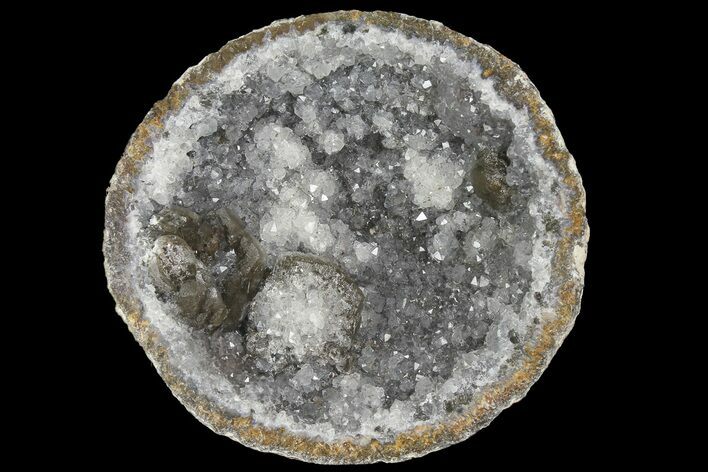This Specimen has been sold.
5.8" Las Choyas "Coconut" Geode with Quartz & Calcite - Mexico
This is a relatively large "coconut geode" from Chihuahua, Mexico. It's lined with quartz crystals and has calcite crystals scattered throughout the quartz. Both halves are included and come with acrylic display stands.
Geodes are rounded, hollow voids in rocks filled with crystals and other minerals. They typically form when air bubbles inside of volcanic rock form hollow cavities. Over time, as mineral-rich water seeps into the rock, those minerals deposit tiny crystals on the sides those hollow cavities. After millions of years, the flow of water gradually builds crystals inside the empty space.
Las Choyas geodes, often referred to as coconut geodes, are mined from 100 to 200 feet below the surface near Chihuahua, Mexico. Shafts are drilled down to the geode-bearing white clay, and then tunnels are dug horizontally to extract the geodes.
The geodes typically range from about 2-6 inches in diameter and can contain a variety of minerals and crystals. Most hollow geodes contain a variety of quartz, ranging from clear quartz to smoky quartz to rarer amethyst. Many secondary minerals, such as goethite, hematite, mordenite, calcite and galena, may also be present in some geodes.
Las Choyas geodes, often referred to as coconut geodes, are mined from 100 to 200 feet below the surface near Chihuahua, Mexico. Shafts are drilled down to the geode-bearing white clay, and then tunnels are dug horizontally to extract the geodes.
The geodes typically range from about 2-6 inches in diameter and can contain a variety of minerals and crystals. Most hollow geodes contain a variety of quartz, ranging from clear quartz to smoky quartz to rarer amethyst. Many secondary minerals, such as goethite, hematite, mordenite, calcite and galena, may also be present in some geodes.
Amethyst is a purple variety of quartz (SiO2) that owes its violet color to natural gamma irradiation, iron impurities, and the presence of trace elements, which result in complex crystal lattice substitutions. It is considered a semi-precious gemstone, and just two centuries ago was considered to have a value on par with diamonds, sapphires, and rubies. The largest and best known amethyst deposits occur in southern Brazil and Uruguay, where they are found in hydrothermally-formed geodes, but many localities around the world produce an amazing variety of amethyst crystals and formations. They are almost always formed in medium- to high-temperature geological settings.
About Calcite Crystals
Calcite crystals are a form of calcium carbonate (CaCO₃) known for their diverse shapes, transparency, and vibrant range of colors. They typically form in rhombohedral, scalenohedral, or prismatic shapes, often with well-defined, sharp edges and glossy surfaces. Calcite crystals are often translucent or transparent, sometimes displaying a double refraction effect where objects viewed through the crystal appear doubled. They can appear in various colors—white, clear, yellow, pink, blue, green, and orange—depending on impurities or trace minerals.
A notable characteristic of calcite is its reaction with weak acids like vinegar, which causes it to effervesce, or fizz, as it releases carbon dioxide. This property makes calcite crystals a key tool in geological identification and studies. Calcite forms in many environments, from sedimentary rocks like limestone and marble to hydrothermal veins.
Calcite crystals are a form of calcium carbonate (CaCO₃) known for their diverse shapes, transparency, and vibrant range of colors. They typically form in rhombohedral, scalenohedral, or prismatic shapes, often with well-defined, sharp edges and glossy surfaces. Calcite crystals are often translucent or transparent, sometimes displaying a double refraction effect where objects viewed through the crystal appear doubled. They can appear in various colors—white, clear, yellow, pink, blue, green, and orange—depending on impurities or trace minerals.
A notable characteristic of calcite is its reaction with weak acids like vinegar, which causes it to effervesce, or fizz, as it releases carbon dioxide. This property makes calcite crystals a key tool in geological identification and studies. Calcite forms in many environments, from sedimentary rocks like limestone and marble to hydrothermal veins.
About Agate
Agate is a variety of microcrystalline quartz (chalcedony) that displays translucence and, in some cases, banding. Agate primarily forms when silica-rich fluids fill pockets within rocks and/or fossils, depositing the silica along the walls of the rock. This process can result in banding patterns, as the compositions and impurities of these depositing fluids change over time. These banding patterns can either form as flat layers, creating linear patterns known as waterline agate, or as rounded layers, forming more common ring-like patterns. These patterns depend on the surfaces available for deposition.
Agate is a variety of microcrystalline quartz (chalcedony) that displays translucence and, in some cases, banding. Agate primarily forms when silica-rich fluids fill pockets within rocks and/or fossils, depositing the silica along the walls of the rock. This process can result in banding patterns, as the compositions and impurities of these depositing fluids change over time. These banding patterns can either form as flat layers, creating linear patterns known as waterline agate, or as rounded layers, forming more common ring-like patterns. These patterns depend on the surfaces available for deposition.
SPECIES
Quartz & Calcite
LOCATION
Chihuahua, Mexico
SIZE
5.8" wide
CATEGORY
SUB CATEGORY
ITEM
#180578
 Reviews
Reviews

















